Trisuit Shootout Part 2: De Soto
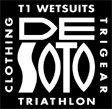
De Soto is probably a company that needs no introduction to most Slowtwitch readers, but since Emilio De Soto provides a nice one on his website, I'll borrow it for the purposes of introducing him, and his company, to those of you that aren't familiar with this pioneering brand: De Soto Sport, was founded by triathlete Emilio De Soto II, has been in existence since 1990. The Cuban-born (now American citizen) is the front man of the company. From the business and product development, to customer service, even to the photography, he is closely involved in every aspect of De Soto Sport. He has a degree in Mechanical Engineering, an MBA in Marketing, but credits his apparel knowledge to the experience he gained when he was sponsored by the founders of the ever successful companies, No Fear, Spy, and Prana. Their work ethics and over 25 consecutive seasons of triathlon competition have molded the company to what it is today. (courtesy DeSotoSport.com)
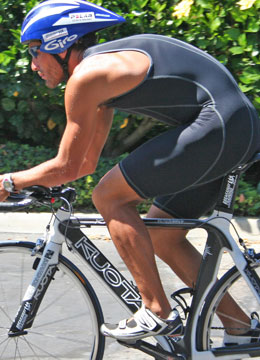
Long a staple of the American triathlon scene, the De Soto Power TriSuit, now known as the Forza, is joined more recently by two other suits in the De Soto line-up. If you look in the De Soto catalog, you'll see the first of these two suits – the Liftfoil, which does double duty as both a trisuit and as a competitor to the swim-skins made famous by Normann Stadler in 2006. The second of these two suits is nowhere to be found in the catalog, but it exists. It is basically whatever you can imagine it to be. All of De Soto's clothing is made right here in the good ole United States of America. Because of this, and because of Emilio De Soto's obsession with customer service, De Soto can (and will) make you custom versions of any of the items in their catalog. De Soto receives so many requests for custom items, ranging from something as small as adding additional pockets to something as intensive as designing a wetsuit for an amputee, that they've started a custom program called Hidden Bay. Emilio didn't build a custom suit for me, but I'll describe the suit I would design at the end.
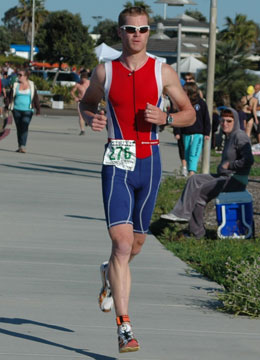
De Soto is a company that is, in many ways, defined by their fabrics. Many of De Soto's fabrics are unique to the company, and they are a big part of why people do (or potentially do not) like their stuff. The cut of the suits is also different than some others, falling into what I'd describe as "comfort through support." De Soto's suits are like briefs, as opposed to the more free and "boxer-like" fit of the Kiwami suits featured in part one of our series. Neither one is better or worse. Just different. Not being a woman, and never having been one, I can't say how these suits would fit that particular gender's anatomy, but if you are, as Dr. Gregory House dubbed us in a recent episode of the show with the same name, a "dangler," then De Soto's suits do a very nice job of cradling and supporting your dangling bits. The cut of the two suits is quite different aside from this, so I'll cover the details of each individually.
Most of the fabrics are unique to DeSoto, so I won't call them "Lycra" or anything else. They are predominately Nylon/Spandex or Polyester/Spandex blends. The pads are a microfleece material, each a single ply (for the review, I have a 2008 Liftfoil, which features a pad, unlike previous generations). The suits are quick drying and of moderate weight. Continuing my weigh-ins for comparison to previous, and future, suits, here is how De Soto's suits stack up:
Dry weight of each suit (all size Medium):
Liftfoil: 186g
Forza: 214g
Weight after 12 minutes agitated wash in cold-water (no detergent):
Liftfoil: 452g
Forza: 718g
Weight after spin cycle:
Liftfoil: 269g
Forza: 317g
The Liftfoil is the newer of the two suits, and De Soto marketed it more as a swimskin than as a trisuit, but I actually think it's the nicer suit of the two. It's available in the full palette of Henry Ford colors – BLACK. It's made of 100% Liftfoil fabric and is designed for non-wetsuit swims. According to De Soto's website, "Liftfoil is a hydrodynamic fabric designed to be worn very tight. When stretched on a moving body, Liftfoil becomes thinner, so it absorbs less water. Because it compresses against the skin, it reduces passive drag, and acts as a foil to lift the body at the water surface." The fabric has a very smooth feel, making it quite comfortable to wear. The long inseam of the suit seems to eliminate the need for leg grippers, using the contour of your thigh to hold the suit in place. I found this worked very well, as the suit didn't ride up at all during cycling or running. The long inseam also meant that almost all of your upper leg is supported with some level of compression (depending on how big your thighs are). The suit pattern is very nice, with no seams at all across or near your waist. There's a pair of seams low across your groin (either side), which is what gives it the very supportive cut, but then it's a single panel up the whole front (and back) of the suit. The armpits receive a "rolled" border, so there is no seam at the armpit edge, an area of regular chaffing. Logoing is typically discrete, with a small De Soto dongle on the zipper and a small logo on the lower left thigh. In the water, the Liftfoil is extremely comfortable and fast. No water entered in under the arms, despite the fact that the suit has a nice cut around the chest and arms that doesn't feel like someone put your pectorals in a vise. When you reach up into the catch position, the stretch seals off the area under your arm, so no water will get in, but leaves that area very free during the pull phase. I was really impressed with how the suit felt swimming. The wide band of fabric at the shoulders meant there was no pull at all from the waist. Speedwise, I don't consider myself consistent enough to really evaluate these things. The Liftfoil is fast, certainly. Faster than anything else? I don't know. But it certainly holds it's own, and considering it is good all day, I think's it's an appealing option for non-wetsuit racing. The suit lacks any pockets, which may present a problem for long course racing, but there are a lot of good options for attaching things to race belts should you decide that this is going to be your trisuit of choice. The suit performs exceptionally well in all disciplines, which really makes it a pleasure to wear. The word from the folks at De Soto is that this is the preferred suit of many of the staffers. For late 2008, De Soto will be releasing a back-zip version of this suit to comply with the coming ITU mandate that age-groupers and pros both race with back-zip suits.
The Forza suit is a very different beast. It is geared specifically towards long course racing, with a heavy emphasis on cycling and running. Given the heavy emphasis of long course racing on these two disciplines, this is probably a good thing. The core of the Forza trisuit is the Lycra Power "shorts." De Soto uses a specific version of Lycra Power, called "The Rib." According to De Soto, "Lycra® Power™ is an Invista Trademark licensed for use on apparel that meets approved performance standards, Lycra® Power™ garments help improve athletic performance by overcoming fatigue and giving an improved sense of body position." Basically, Lycra Power is a compression-focused fabric. And it does this very well. The Forza trisuit feels like a pair of compression shorts (minus the waistband) attached to a lightweight top. De Soto shifts the seam separating the top from bottom into a "V" shape, cutting low just above your crotch and then high over the top of your hip bones. The shorts do a very good job of compressing and supporting your muscles. The fabric is a bit heavy, and it takes a bit of time to shift appropriately on the bike when you are down in your aerobars (the first 10-15 minutes, I found it bound up a bit over my hip flexors, but I ride with quite a lot of drop, so I'm sure this is part of it). Once it settles, which is easy without the leg grippers, it is very comfortable. To be clear, settling is not the same as riding up. It doesn't ride up, it just sort of shifts to accommodate your pedaling. I personally like a bit more freedom for long runs, but if you like compression, you'll like this suit. The top of the suit is made from a mix of De Soto's SPF Carrera fabric (blocks 75% of UVB rays) that also is designed to stay smooth even when wet for minimal chafing. This material is used for the main front and back of the suit. Underneath the arms, is the very porous Liquid Mesh fabric, which offers a lot of breathability. The suit features three pockets on the very low back, at the top of the "compression short" and two pockets on the side of each thigh. The heavy compression fabric keeps things from moving around at all, and the center pocket is large enough to hold a spare tube and CO2 comfortably, though I'm not sure I'd want to race all day with them stuffed in there. The pockets are cut tight, though I don't think I'd want to wear the suit for a non-wetsuit swim. It also took on a fair bit more water than the Liftfoil, so keeping it under a wetsuit would probably help alleviate that. It's a suit geared towards getting you through the run and bike with maximum support, and if that is what you are looking for, this is your suit.
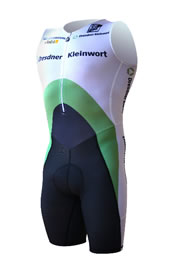
Now, given De Soto's custom options, if I was designing a suit, I'd ask for the following: I like the pattern of the Liftfoil, but I'd want to main back panels to be white. I also would prefer a back zipper, since I think they seem to put the suit in a better position in terms of not chafing your nipples, and they also look nicer, which is important for race photos! I'd also ditch the pad, and wear a swim-brief (aka speedo) underneath, since I find this to the most comfortable way to race. And, were I to ask for a custom suit, I'd have the comfort of knowing that I wasn't the first to do so. De Soto has a pretty impressive list of customers, including Normann Stadler, who purchased the suit seen here for his race at Ironman Germany.
My complaint in terms of the comfort is that I don't love these microfleece pads that seem to be rather ubiquitous in triathlon these days, and if I had to pick a fault with both suits, this would be it. Trisuit pads seem to be light years behind cycling pads in terms of materials. I understand that making a pad that works well in the water is not easy, but I don't think, personally, that fleece is the answer. I don't know what is, but I prefer a less rough fabric. I think a double layer of the Liftfoil fabric would be a better "pad," especially considering the additional padding of most tri-specific saddles. You also sit on a tri-saddle so differently when you are down in your aerobars, and I just don't think this has been addressed enough. Considering how long something like an Ironman bike is, I understand why many people choose to put on bike shorts for that portion, especially when trisuits don't seem to measure up in the pad department. I have great faith in De Soto's ability to come up with new fabrics and materials, and I'm hoping that they can solve this riddle, since they would have a very serious advantage if they do.
All suits are made in the USA using 100% flat-lock stitching and YKK-brand zippers. Every De Soto garment features a 90-day 100% satisfaction guarantee.
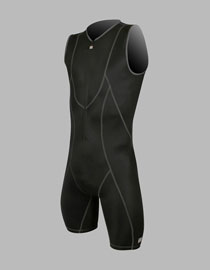
Liftfoil
Price: 170 USD
Inseam: 24cm (9.5 inches)
Width at the top of the shoulder: 9cm (3.5 inches)
Pad: Yes. Thin microfleece. Smaller cut that Forza suit.
Stitching: 100% flatlock stitching
Zipper: Front-zip. Opens 40cm (15.5 inches) inches. Comes with pull-leash for easy zip-up/zip-down.
Materials: Liftfoil (De Soto custom textile)
Pockets: None
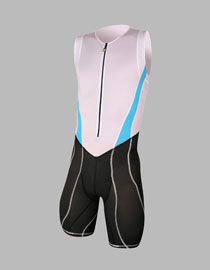
Forza
Price: 118 USD
Inseam: 24cm (9.5 inches)
Width at the top of the shoulder: 9cm (3.5 inches)
Pad: Yes. Microfleece. Larger cut than Liftfoil.
Stitching: 100% flatlock stitching
Zipper: Front-zip. Opens 40cm (15.5 inches) inches. Comes with pull-leash for easy zip-up/zip-down.
Materials: Legs – Lycra Power Ribbed; Chest – Carrera Skin and Liquid Mesh (De Soto custom textiles)
Pockets: Five – three back, two leg
For more on De Soto and to see their complete line-up, visit www.desotosport.com.

